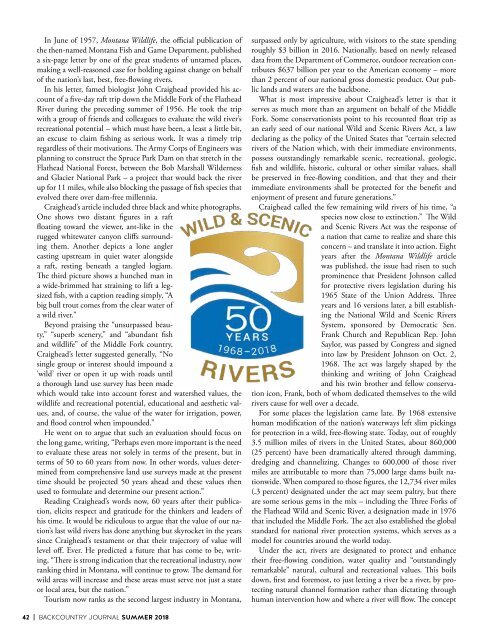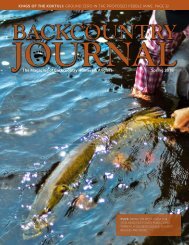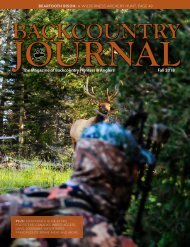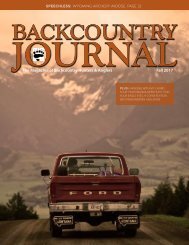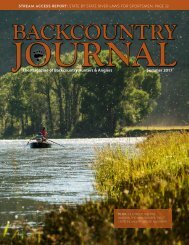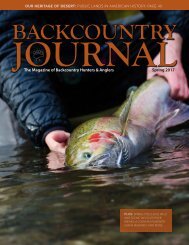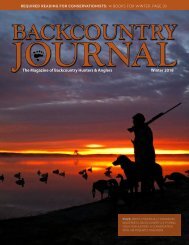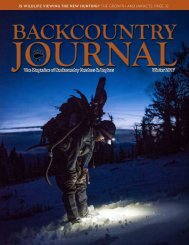BCJ_SUMMER18 Digital Edition
- No tags were found...
Create successful ePaper yourself
Turn your PDF publications into a flip-book with our unique Google optimized e-Paper software.
In June of 1957, Montana Wildlife, the official publication of<br />
the then-named Montana Fish and Game Department, published<br />
a six-page letter by one of the great students of untamed places,<br />
making a well-reasoned case for holding against change on behalf<br />
of the nation’s last, best, free-flowing rivers.<br />
In his letter, famed biologist John Craighead provided his account<br />
of a five-day raft trip down the Middle Fork of the Flathead<br />
River during the preceding summer of 1956. He took the trip<br />
with a group of friends and colleagues to evaluate the wild river’s<br />
recreational potential – which must have been, a least a little bit,<br />
an excuse to claim fishing as serious work. It was a timely trip<br />
regardless of their motivations. The Army Corps of Engineers was<br />
planning to construct the Spruce Park Dam on that stretch in the<br />
Flathead National Forest, between the Bob Marshall Wilderness<br />
and Glacier National Park – a project that would back the river<br />
up for 11 miles, while also blocking the passage of fish species that<br />
evolved there over dam-free millennia.<br />
Craighead’s article included three black and white photographs.<br />
One shows two distant figures in a raft<br />
floating toward the viewer, ant-like in the<br />
rugged whitewater canyon cliffs surrounding<br />
them. Another depicts a lone angler<br />
casting upstream in quiet water alongside<br />
a raft, resting beneath a tangled logjam.<br />
The third picture shows a hunched man in<br />
a wide-brimmed hat straining to lift a legsized<br />
fish, with a caption reading simply, “A<br />
big bull trout comes from the clear water of<br />
a wild river.”<br />
Beyond praising the “unsurpassed beauty,”<br />
“superb scenery,” and “abundant fish<br />
and wildlife” of the Middle Fork country,<br />
Craighead’s letter suggested generally, “No<br />
single group or interest should impound a<br />
‘wild’ river or open it up with roads until<br />
a thorough land use survey has been made<br />
which would take into account forest and watershed values, the<br />
wildlife and recreational potential, educational and aesthetic values,<br />
and, of course, the value of the water for irrigation, power,<br />
and flood control when impounded.”<br />
He went on to argue that such an evaluation should focus on<br />
the long game, writing, “Perhaps even more important is the need<br />
to evaluate these areas not solely in terms of the present, but in<br />
terms of 50 to 60 years from now. In other words, values determined<br />
from comprehensive land use surveys made at the present<br />
time should be projected 50 years ahead and these values then<br />
used to formulate and determine our present action.”<br />
Reading Craighead’s words now, 60 years after their publication,<br />
elicits respect and gratitude for the thinkers and leaders of<br />
his time. It would be ridiculous to argue that the value of our nation’s<br />
last wild rivers has done anything but skyrocket in the years<br />
since Craighead’s testament or that their trajectory of value will<br />
level off. Ever. He predicted a future that has come to be, writing,<br />
“There is strong indication that the recreational industry, now<br />
ranking third in Montana, will continue to grow. The demand for<br />
wild areas will increase and these areas must serve not just a state<br />
or local area, but the nation.”<br />
Tourism now ranks as the second largest industry in Montana,<br />
surpassed only by agriculture, with visitors to the state spending<br />
roughly $3 billion in 2016. Nationally, based on newly released<br />
data from the Department of Commerce, outdoor recreation contributes<br />
$637 billion per year to the American economy – more<br />
than 2 percent of our national gross domestic product. Our public<br />
lands and waters are the backbone.<br />
What is most impressive about Craighead’s letter is that it<br />
serves as much more than an argument on behalf of the Middle<br />
Fork. Some conservationists point to his recounted float trip as<br />
an early seed of our national Wild and Scenic Rivers Act, a law<br />
declaring as the policy of the United States that “certain selected<br />
rivers of the Nation which, with their immediate environments,<br />
possess outstandingly remarkable scenic, recreational, geologic,<br />
fish and wildlife, historic, cultural or other similar values, shall<br />
be preserved in free-flowing condition, and that they and their<br />
immediate environments shall be protected for the benefit and<br />
enjoyment of present and future generations.”<br />
Craighead called the few remaining wild rivers of his time, “a<br />
species now close to extinction.” The Wild<br />
and Scenic Rivers Act was the response of<br />
a nation that came to realize and share this<br />
concern – and translate it into action. Eight<br />
years after the Montana Wildlife article<br />
was published, the issue had risen to such<br />
prominence that President Johnson called<br />
for protective rivers legislation during his<br />
1965 State of the Union Address. Three<br />
years and 16 versions later, a bill establishing<br />
the National Wild and Scenic Rivers<br />
System, sponsored by Democratic Sen.<br />
Frank Church and Republican Rep. John<br />
Saylor, was passed by Congress and signed<br />
into law by President Johnson on Oct. 2,<br />
1968. The act was largely shaped by the<br />
thinking and writing of John Craighead<br />
and his twin brother and fellow conservation<br />
icon, Frank, both of whom dedicated themselves to the wild<br />
rivers cause for well over a decade.<br />
For some places the legislation came late. By 1968 extensive<br />
human modification of the nation’s waterways left slim pickings<br />
for protection in a wild, free-flowing state. Today, out of roughly<br />
3.5 million miles of rivers in the United States, about 860,000<br />
(25 percent) have been dramatically altered through damming,<br />
dredging and channelizing. Changes to 600,000 of those river<br />
miles are attributable to more than 75,000 large dams built nationwide.<br />
When compared to those figures, the 12,734 river miles<br />
(.3 percent) designated under the act may seem paltry, but there<br />
are some serious gems in the mix – including the Three Forks of<br />
the Flathead Wild and Scenic River, a designation made in 1976<br />
that included the Middle Fork. The act also established the global<br />
standard for national river protection systems, which serves as a<br />
model for countries around the world today.<br />
Under the act, rivers are designated to protect and enhance<br />
their free-flowing condition, water quality and “outstandingly<br />
remarkable” natural, cultural and recreational values. This boils<br />
down, first and foremost, to just letting a river be a river, by protecting<br />
natural channel formation rather than dictating through<br />
human intervention how and where a river will flow. The concept<br />
Dusty Vaughn/USDA Forest Service graphic<br />
of “outstandingly remarkable values” is notable in that it protects<br />
specific values that are “rare, unique, or exemplary” on a regional<br />
or national scale – in other words, conserving the very best of the<br />
best in fisheries, wildlife, scenery, recreation, geology, and historic<br />
and cultural resources.<br />
Segments are classified as one of three categories: wild, scenic<br />
or recreational, based on the level of development present in the<br />
river corridor at the time of designation. That baseline of development<br />
then serves as the minimum standard for management<br />
– in perpetuity. The Bureau of Land Management, National Park<br />
Service, U.S. Fish and Wildlife Service and Forest Service each<br />
work with numerous partner organizations to manage designated<br />
rivers, both on federal and non-federal lands.<br />
Despite the small fraction of our national river network protected<br />
under the Wild and Scenic Rivers Act, stretches are accessible<br />
from most spots on the map. The national system today<br />
includes rivers in 40 states, plus Puerto Rico. Even major metropolitan<br />
areas like New York City, Los Angeles and Philadelphia<br />
have multiple designated rivers within 60 miles of town. Portland<br />
is particularly well off, with 16 designated stretches within<br />
60 miles. And these rivers provide benefits even to those who will<br />
never visit them, with one in 10 people in the United States today<br />
drinking water that can be traced to a wild and scenic river.<br />
For my buddies and me it was spring steelhead runs and squirrel,<br />
turkey and waterfowl hunting along the steep, sandy banks of<br />
the Manistee River in Michigan’s Lower Peninsula that first drew<br />
our attention to a place protected by this legislation. Twenty-six<br />
miles of the Manistee were designated as wild and scenic in 1992,<br />
with an emphasis on “outstandingly remarkable” fish, wildlife and<br />
recreational values. Having the Manistee within jalopy distance<br />
was a point of gratitude for a group of friends who drove rust<br />
bucket pickup trucks that often shared birth years with their drivers.<br />
But we were both grateful and naïve. We didn’t comprehend<br />
that, through the Wild and Scenic Rivers Act, we were inheriting<br />
something special from a generation of thinkers who had people<br />
like us specifically in mind as future beneficiaries.<br />
“Any outdoor pursuit which brings a [person] into intimate<br />
contact with natural scenery, natural forces, and the unaltered<br />
web of life is highly educational. The right to experience this<br />
should be as inalienable as freedom of worship. To preserve it is<br />
a trust falling to each succeeding generation.”<br />
-John Craighead<br />
As inalienable as freedom of worship.<br />
It makes sense given that there are those of us whose connections<br />
to higher powers hinge on intimate contact with natural<br />
scenery, natural forces and the unaltered web of life.<br />
There are a pair of popular concepts bandied about when watershed<br />
protection is being discussed: We all live downstream and we<br />
all live upstream. They are ideas so basic and overstated that they<br />
risk becoming cliché. But when considering the inheritance of a<br />
distinct, favorite stretch of river, time itself can take on a river-like<br />
quality that reaffirms these simple, elegant principles. People like<br />
the Craighead brothers, Sen. Church, Rep. Saylor and President<br />
Johnson are easily classified today as upstream benefactors, with<br />
places like the Middle Fork of the Flathead and the Manistee River<br />
a tangible trust flowing to successive generations of recipients –<br />
including us. This line of thinking then unavoidably underscores<br />
a conclusion that each generation, including ours, is positioned<br />
both to receive from upriver and to affect all those downstream –<br />
for better or worse.<br />
So let’s be wise and take note of the insight of our predecessors.<br />
This year let’s celebrate the 50 th anniversary of the Wild and<br />
Scenic Rivers Act with our attention focused on year 100. With<br />
regard to wild rivers and otherwise, let’s do everything we can to<br />
rank among those who are viewed favorably from downstream<br />
when our turn as generational trustees is over.<br />
As we’ve been shown, there is no better legacy than leaving<br />
something irreplaceable behind when we go.<br />
Karl is the regional wildlife ecologist for the Southwestern Region of<br />
the Forest Service and a lifetime member of BHA. He is grateful for<br />
the privilege of working for you in helping care for our public lands<br />
and waters – the greatest public lands system on the planet.<br />
42 | BACKCOUNTRY JOURNAL SUMMER 2018<br />
SUMMER 2018 BACKCOUNTRY JOURNAL | 43


